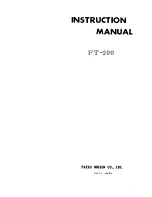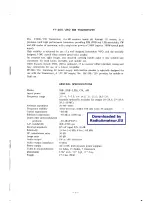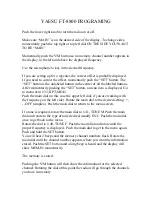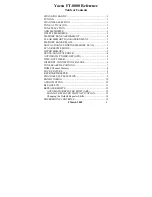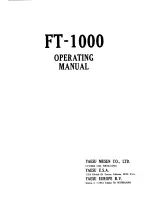
P a g e
|
21
20-62 VHF & UHF TRANSMITTER
Product Manual
Sea Air and Land Communications Ltd, 10 Vanadium Place, Addington, Christchurch 8024, New Zealand
March 2020
Selecting an IP address
Selecting a valid IP address for the 20-62 to use on your network will depend on how your network
is configured. If you have a network administrator they may be able to assist with the selection
and reservation of a valid IP address on their network.
Typically the 20-62 IP address will be valid only on your local network. IP addresses on your
network will be managed according to how the network is set up. Typically all devices on the
local network will have the same 3 numbers for the first part of the address, and only the last
number will change from device to device, for example 192.168.1.xxx. Typically these first 3
numbers must be the same at both ends to establish a connection.
Manually assigning a static address
To manually assign a static IP address to the 20-62 select “STATIC” for the “IP address mode”.
Enter the IP address into the “Static IP address” field, and write the settings to the 20-62.
The advantage of a static address is that it will not change, so a client will always know the
address of the 20-62 on the network.
To avoid conflicts, the IP address must be unique on your local network.
Typically IP addresses are assigned automatically by a DHCP server on your network. Addresses
are assigned from a range of addresses programmed into the DHCP server (the DHCP pool).
When selecting an IP address manually you must make sure that the DHCP server will not
automatically assign the same address to another device. The IP address must either be outside
the DHCP pool or reserved for the 20-62 by the DHCP server.
Automatically assigning an IP address
You can use the DHCP server to automatically assign a unique IP address to the 20-62. Select
“DHCP” as the “IP address mode”. This is the easiest way to ensure that the 20-62 has a unique
address, however this address could change next time the 20-62 is connected.
The DHCP server will reserve the address for a “lease” period programmed into the DHCP server.
This may be a day or a week, or as short as an hour or less. The 20-62 will continue to renew this
lease as long as it is active, but if it is disconnected or powered off, the address may be
reassigned to another device after the lease period expires. When the 20-62 is re-connected to
the network it will request the same IP address that it had last time, but if it is not available the 20-
62 will receive a new address.
If the 20-62 is configured as a “TCP/IP client” the 20-62 will initiate the connection with the “remote
server”, so the IP address of the 20-62 does not matter, provided it is valid. In this case the DHCP
server may be used to assign the IP address without concern.
Once a unique address has been assigned by the DHCP server, this address can usually be
permanently reserved by configuring the DHCP server to reserve that address. This address should
then be configured as the “static” IP address in the 20-62. Refer to your network administrator or
router manual.































